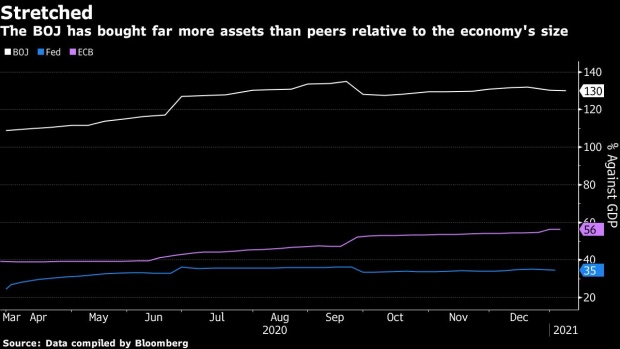Jan 19, 2021
Asian Central Banks Start Year Juggling Politics, Policy Reviews
, Bloomberg News

(Bloomberg) -- Central banks across Asia are starting the year juggling policy reviews and political pressure to do more to support their economies.
Bank of Japan Governor Haruhiko Kuroda has promised to release a policy review in March that he emphasized isn’t intended to backpedal from massive monetary easing, but rather to make it “more effective and sustainable.” The Reserve Bank of India is reviewing its inflation-targeting mechanism, with some in Prime Minister Narendra Modi’s government seeking to widen the band from the current 2%-6% range.
In Southeast Asia, the Indonesian and Philippine central banks face pressure to help finance widening budget deficits as their governments battle severe coronavirus outbreaks. Central bankers in Seoul and Wellington are being prodded by lawmakers to act on unemployment and soaring house prices, respectively.
The list of variables highlights the pressure to continue stimulating at a time when the global economy is leaning on Asia to lead the recovery as vaccine roll out gets off to a cautious start. While the Federal Reserve’s promise to keep interest rates low will help Asian central banks’ cause, the recent march of 10-year bond yields to more than 1% shows how quickly the international backdrop can shift.
“Central bankers all over the world now are looking to shoulder their part of a much broader burden,” said Ben Powell, chief Asia Pacific investment strategist for the BlackRock Investment Institute. “It’s the blending now that we are seeing all over the world, including in Asia.”
Policy makers in Malaysia and Indonesia meet this week, and while no change is expected in either case, economists say both could be candidates to lower rates further or take other measures in coming months. The BOJ meets Wednesday and Thursday, with no change expected to its main policy settings. India and the Philippines are others tipped for possible easing in coming months.
What Bloomberg Economics Says...
Asia’s central banks are expected to maintain easing stances, though the extent of further rate cuts may vary:
- The Reserve Bank of India is likely to resume its easing cycle now that inflation has fallen back below 6%, the top of its target range
- Bank Indonesia may not be done cutting rates. The RBNZ and Bank Negara Malaysia have indicated willingness to do more.
- On the other hand, the Bank of Korea, Bangko Sentral ng Pilipinas and Bank of Thailand might not be able to cut rates further. Instead, some of them might use more targeted monetary measures.
-- Chang Shu, chief Asia economist
Bank Indonesia halted direct purchases of government debt this year, but investors are still watching for any changes to its mandate as part of sweeping reforms lawmakers aim to impose across the financial sector. A similar proposal last year was abandoned after widespread concern it would erode the monetary authority’s independence.
President Joko Widodo, who is said to have led the push to reform the BI, in December renewed calls for greater coordination between the central bank and government, saying “institutional egoism” had no place in the pandemic..
In Manila, the government took out another $11-billion lifeline from the central bank in December -- the third time it has borrowed from the central bank -- just days after repaying a loan for the same amount. It has space to borrow an additional $5.9 billion this year after a pandemic relief law temporarily raised the cap on credit the BSP can extend to the government.
With fiscal space more limited, the pressure will remain on Asia’s central banks to do more, said Tuuli McCully, the Singapore-based head of Asia Pacific economics at Scotiabank.
“Because of the surge in Covid-19, domestic demand remains soft in many countries in the region and further monetary stimulus may be needed,” she said.
©2021 Bloomberg L.P.






